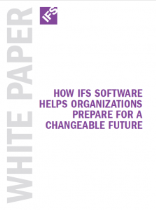
Don’t dip your business in concrete by implementing the wrong ERP system. Read our new whitepaper on how IFS helps organizations prepare for a changeable future!
It is an old joke, that may sometimes target specific software vendors, that implementing enterprise resource planning (ERP) software or other enterprise software may be akin to dipping your business in concrete.
You go into a room with a systems integrator and re-engineer your processes for six months. You then go through an implementation process that may take years. The implementation is rife with modifications to the source code, unpleasant twists and turns and a training program for users that, to them, feels like a Kafkaesque nightmare as they struggle to learn the byzantine structure of their new computing environment.
And then, wonder of wonders, the system is in place. And it encompasses a front-to-back business process — quote to cash, an asset lifecycle, a product lifecycle. It rolls all of these projects, products, assets up into a company-wide view so senior management can run the business. You have reached your business destination!
But then, something terrible happens.
Something changes.
Maybe you acquire a new division. Or begin engineering products to meet specific customer needs. Or you add an aftermarket service division to mine additional revenue from customers after the sale. These are all positive, growth-oriented changes. But guess what? The biggest barrier you face to successfully undertaking your initiatives may be your own enterprise software. In fact, major business change is, according to ERPFocus.com, one indicator that the software you just worked so hard to implement may be obsolete. So business change and growth may mean you have grown right out of your enterprise software!
You may need to select and implement new software, re-implement the suite or have consultants modify the source code. These modifications always increase expense and risk on a number of levels.
Either way, enterprise software can in fact turn into a barrier to business agility, a barrier to growth, a barrier to success. This takes a lot of courage for someone in the enterprise software business to say, but it is often true.
Engineering for change
In a new series of whitepapers from IFS, we take an extended look at the importance of business agility. We explore the philosophical disciplines and the management processes required to deliver enterprise agility. As we established above, in some situations, enterprise software can be as big a barrier as an aid in adapting to change. So we also take time to outline IFS’ approach to ensuring our software enhances rather than limits business agility. In the latest of the series, “How IFS Software Helps Organizations Prepare for a Changeable Future,” we start to really address the software requirements for business agility. In this document, we identify four traits that enterprise software must exhibit to facilitate change:
1) Modularity
2) Effective Research and Development
3) Specialization rather than modification
4) Global Competency
The whitepaper calls out specific customers including Value Plastics, Portsmouth Aviation and E&I Engineering as examples of companies making the most of the business agility enabled by IFS and IFS Applications.

KnowITERP
KnowITERP-very well written post and thanks for sharing this.
Datix, Inc.
Fantastic post, thanks for your honesty about the misconceptions of ERP implementation.